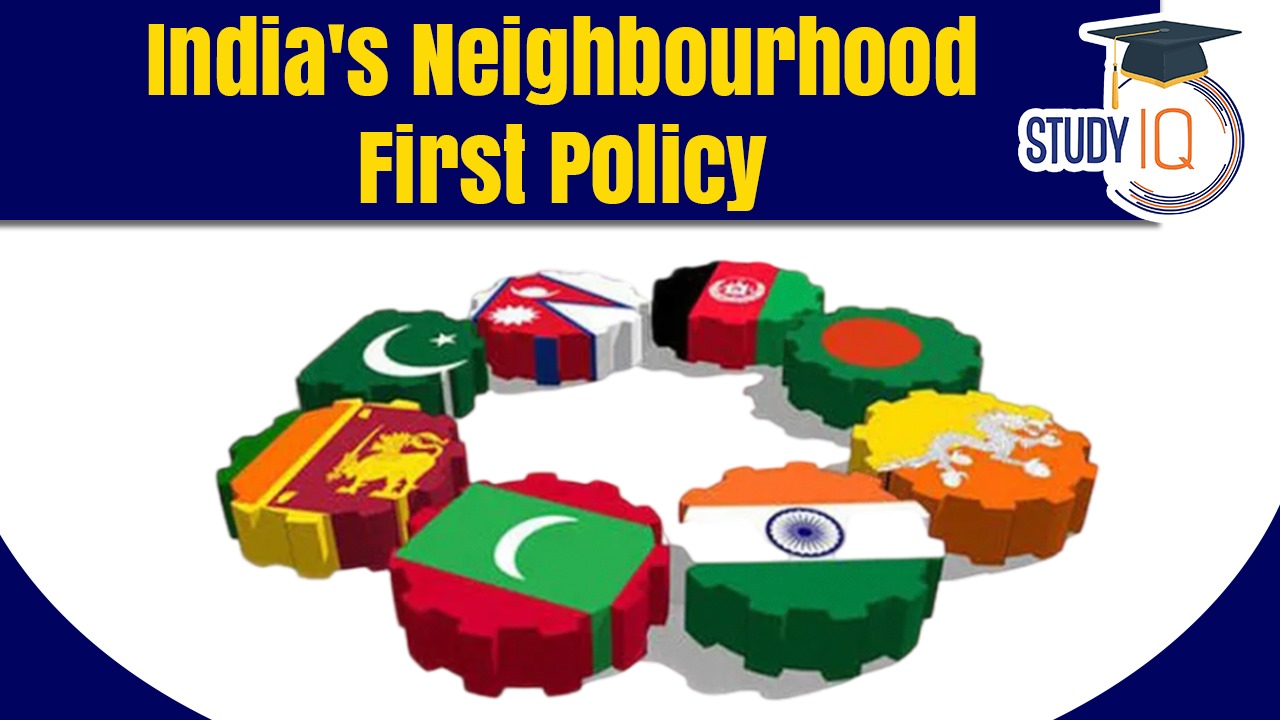Table of Contents
Context: In keeping with the government’s “Neighborhood First” policy, Bhutan was allocated ₹2,068 crore from the total external aid portfolio.
Neighbourhood First Policy
- Neighbourhood First Policy is a dynamic policy that was conceived around 2008 to forge strong neighbourhood relations based on a consultative, non-reciprocal and outcome-oriented approach.
- It emphasises creating a peaceful, prosperous, and stable neighbourhood through enhanced connectivity, economic cooperation, and people-to-people exchanges.
- The priority countries under the policy are
- Afghanistan,
- Bangladesh,
- Bhutan,
- Nepal,
- Maldives,
- Myanmar,
- Pakistan and Sri Lanka.
- Under the Neighbourhood First Policy, India also engages with its neighbours under regional frameworks like SAARC, BIMSTEC, Bangladesh Bhutan-India-Nepal (BBIN) etc.
Principles of ‘Neighbourhood First’ policy
- Sovereignty and territorial integrity
- Mutual respect and sensitivity
- Non-interference in internal affairs.
- Shared prosperity
- Connectivity for regional integration
- People-to-people exchanges
| Recent developments related to the ‘Neighbourhood First’ policy |
|
Challenges Facing Neighbourhood First Policy
- Threats from Cross-Border Terrorism and Other Illicit Activities: India faces persistent challenges from cross-border terrorism, illegal migration, smuggling, drug trafficking, and weapons trafficking from some of its neighbouring countries. These security concerns hinder the smooth implementation of the Neighbourhood First Policy.
- Delays in Development Projects: The implementation of development projects in neighbouring countries often faces delays due to various factors, including bureaucratic hurdles, political instability in the region, and differing priorities among the nations.
- China’s Belt and Road Vision and America’s Indo-Pacific Vision: India’s neighbours have been courted by other major powers, such as China with its Belt and Road Initiative and the United States with its Indo-Pacific vision. These initiatives can create complexities for India’s Neighbourhood First Policy as they offer alternative avenues for economic and strategic engagement.
- Limited Parliamentary Exchanges: Meaningful parliamentary exchanges between India and its neighbours are essential for fostering closer ties and better understanding. However, limited interactions at the parliamentary level may hinder the growth of bilateral relationships.
- Deficiency in Border Infrastructure, Especially in the North-Eastern Region: Inadequate border infrastructure, particularly in the North-Eastern region (NER), poses challenges in strengthening connectivity and trade with neighbouring countries. This deficiency may slow down the progress of the Neighbourhood First Policy in these regions.
Key Recommendations for Neighbourhood First Policy
- Dynamic Policy: India’s Neighbourhood First Policy is dynamic and adjusts to the country’s changing interests in the region while adapting to regional circumstances.
- Economic Ties with Pakistan: The Government should consider establishing economic ties with Pakistan if they take steps towards broader people-to-people contacts.
- The emphasis is placed on the cultural commonalities and civilizational linkages between the two countries, promoting cooperation and reducing feelings of enmity among citizens.
- Focus on Smaller Neighbours: India to engage and deepen ties with smaller neighbouring countries. This approach is seen as crucial for India’s strategic interests and foreign policy requirements.
- South Asian Market Opportunities: Grasp and consolidate opportunities presented by an open and competitive South Asian market from both security and economic perspectives.
- Counter terrorism: Terrorism emanating from territories under Pakistan’s control is one of the core concerns. The onus is placed on Islamabad to create a conducive atmosphere for meaningful dialogue.
- International Engagement: India’s proactive outreach with the international community to counter Pakistan’s attempts to present an alarmist situation of the region, interfere in India’s internal affairs, and internationalise bilateral issues.
- Engaging Regional and Multilateral Bodies: In view of Pakistan’s belligerent attitude, the Government should continue to proactively engage with regional and multilateral bodies/organisations to sensitise them about Pakistan’s role in fostering terrorism and to seek support in the fight against terrorism on Pakistani soil.
Government Initiatives to Harmonise Neighbourhood Relations
India has undertaken various initiatives to harmonise relations with its neighbours in the region.
- Neighbourhood First Policy: India’s Neighbourhood First Policy is based on the principles of mutual respect, understanding, and sensitivity to each other’s concerns and priorities. It aims to prioritise India’s relations with its neighbouring countries and foster stronger ties.
- Act East Policy: The Act East Policy is focused on enhancing ties with the countries of Southeast Asia and the Asia-Pacific region. It seeks to boost economic, cultural, and strategic linkages with these nations.
- Connectivity Initiatives: India is actively promoting connectivity initiatives to improve transportation and trade links with its neighbours. Some of these initiatives include the international north-south transport corridor, the Chabahar port in Iran (which facilitates access to Afghanistan and Central Asia), and the Kaladan multimodal transit transport project in Myanmar.
- Development Cooperation: India provides development assistance to its neighbours through various initiatives such as the Indian Technical and Economic Cooperation (ITEC) Program and the Indian Council for Cultural Relations (ICCR). These programs aim to support capacity building, education, healthcare, and cultural exchange.
- Vaccine Diplomacy: India has played a significant role in the region’s fight against COVID-19 by providing vaccines to its neighbouring countries under its vaccine diplomacy initiative. This has helped strengthen India’s ties and goodwill in the region.
- Sub-regional Initiatives: India is part of sub-regional groupings such as the Bangladesh–Bhutan–India–Nepal (BBIN) network. These initiatives aim to enhance cooperation and connectivity among the participating countries.
- Country-Specific Initiatives: India has country-specific initiatives with its neighbours, such as the Indo-Bhutan treaty of peace and friendship, agreements related to hydropower projects with Nepal, providing financial support to Bhutan’s five-year plans, and assisting Sri Lanka during its balance of payment crisis.
- Science and Technology Cooperation: India launched the South Asia Satellite (SAS) to improve communication and disaster management links among its South Asian neighbours. This initiative helps in sharing valuable data and resources in times of crises.
- Physical and Energy Connectivity: India has been actively engaged in physical and energy connectivity projects, such as the Chabahar port, Kaladan project, grid interconnection with Nepal, Bhutan, and Bangladesh, and power projects in Bangladesh and Bhutan.
- Trade Connectivity and Market Access: India has facilitated trade connectivity through special market access, financial assistance, and border crossings with neighbouring countries. This includes initiatives like Lines of Credit to Sri Lanka and land custom stations with Bangladesh.
- Humanitarian Assistance: India provides humanitarian assistance to its neighbours through early warning systems, disaster relief efforts, and aid deployment during natural disasters and emergencies.
- Example: In 2020, India provided relief assistance to Bangladesh following the devastating impact of Cyclone Amphan, including essential supplies and support for rehabilitation efforts.


 Current Global Crises and Geopolitical D...
Current Global Crises and Geopolitical D...
 Strategic Importance of Crimea to Russia
Strategic Importance of Crimea to Russia
 Political Trilemma Concept and Crisis in...
Political Trilemma Concept and Crisis in...





















